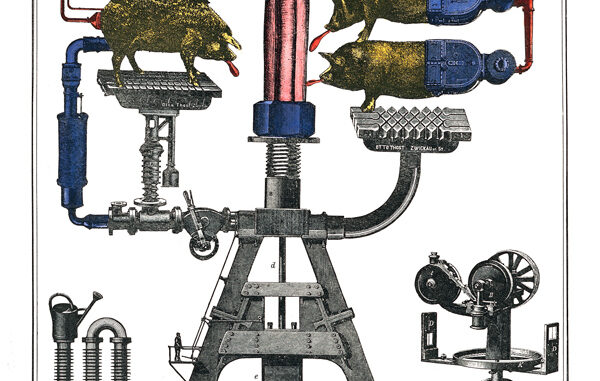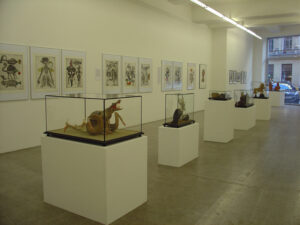
This show came as a surprise. Jan Švankmajer, worldwide renowned filmmaker, is exhibiting in a commercial Viennese gallery. And he is not exhibiting props or film stills, he isn’t screening a film either. He is showing a whole oeuvre of artworks, a whole parallel artistic universe that kept growing behind the backdrop of his films‘ stage over the last forty or so years: collages, assemblages, etchings, prints, cut outs and objects – over sixty pieces, which together form an eccentric Wunderkammer, turning the interior of the Kerstin Engholm Gallery into a little museum of unnatural history.
Švankmayer, who is as old as Czech surrealism itself (he was born 1934, the same year when the Czech Surrealist Group was officially formed) is still artistically active and planning another feature-length movie. His last film, called “Surviving life – theory and praxis” („P?ežít svuj život (teorie a praxe“) which came out in 2010, was awarded with the Czech Lion last year (Best Art Direction) and is now showing all across Europe, from Las Palmas to Warsaw. “Surviving Life” is much different than Švankmajer’s earlier features (“Alice” 1988, „Conspirators of Pleasure“ 1996, “Little Otik” 2000) – and hardly as disturbing. But in case of objects even the most recent pieces keep up the gloomy and intensively sexual surrealist style Švankmajer has always been known for. It is surprising how coherent the exhibition is, regardless of the 40 years spread between the productions of individual pieces.
The coherence results partially from certain leit-motifs, which keep reappearing throughout Švankmajer‘s oeuvre. One of these is the figure of Giuseppe Arcimboldo, known for painting manlike faces made up of different objects. In 1982 Švankmajer produced a short animated movie called “Dimensions of Dialogue” where two arcimboldesque heads continuously devour, digest and vomit one another thus creating renewing constellations of objects, which then again arrange themselves into manlike busts. Exactly this method of visual devouring and rumination of artistic material in order to rearrange it into new compositions seems to pertain through the whole show, highlighting the works’ internal logic. Male and female genitals, animal bodies and skeletons, precise clockwork mechanisms reproduced with great accuracy – in various rearrangements these elements return in most of the presented collages and sculptures. The oneiric flux of connections that are made between them strikes as a kind of consistency that only a surrealist mind – caught between dream and reality – could produce.
There is certainly a method to this madness – many critics have emphasized the logical character of Švankmajer’s work as the feature that distinguishes him from former surrealists. Methodology of both presentation and arrangement of artistic material is partially inspired by the displays found in anatomy books and natural science laboratories. The exhibition in Kerstin Engholm Gallery presents a whole set of hand colored engravings of various animal–like fantastic creatures that result from adopting of this anatomic esthetic. The classification and collection of the beings in an encyclopedic manner is an attempt to enclose the knowledge – typical of the collector – in a certain order. Therefore Švankmajer gives names to the newly constructed creatures (like “Caudator Pudicus”, or “Fallaceus Oidipus”); he locates them in ranks of grades and species and gives them a taxonomic justification, which legitimates their existence. In between these etchings, enclosed in glass cabinets, few of such fantasy creatures are placed, as if to exemplify Švankmajer´s „unsysthematic anatomy´s“ working in real.
One group of works differs somewhat from the rest, for it addresses that one of our senses that the cinema is seemingly not concerned with: the sense of touch. Švankmajer has devoted an intense study to tactile experience and the sensations it evokes. The „Tactile poems“ and „Tactile collages“ were produced initially in the 1970s when he had been banned from working as a cinema director, but he did not stop making them even after resuming his cinematographic practice. And although cinema is primarily an audiovisual form, Švankmajer’s way of filming is indeed very tactile. Presented here assemblages of various organic materials (wood, paper, clay, bones, fur) invite us to activate our sense of touch – in doing so they negate the usual gallery situation where „do not touch“ sign is a common sight.
Leaving Švankmajer’s cabinet of curiosities we stumble upon another one – just a door down the Schleifmuhlgasse, one more Wunderkammer opens. In Georg Kargl Fine Arts Gallery the artist Mark Dion presents an exhibition in which he too refers to museums of natural history and their ways of appropriating nature. Called “Fresh Sculpture” the show offers necessary intellectual refreshment after the dense atmosphere of Švankmajer’s imagery.
 images courtesy Gallery Kerstin Engholm
images courtesy Gallery Kerstin Engholm
copyright of the invitation card image: Jan Svankmajer & Athanor
https://www.kerstinengholm.com
(until march 10th)


Leave a Reply